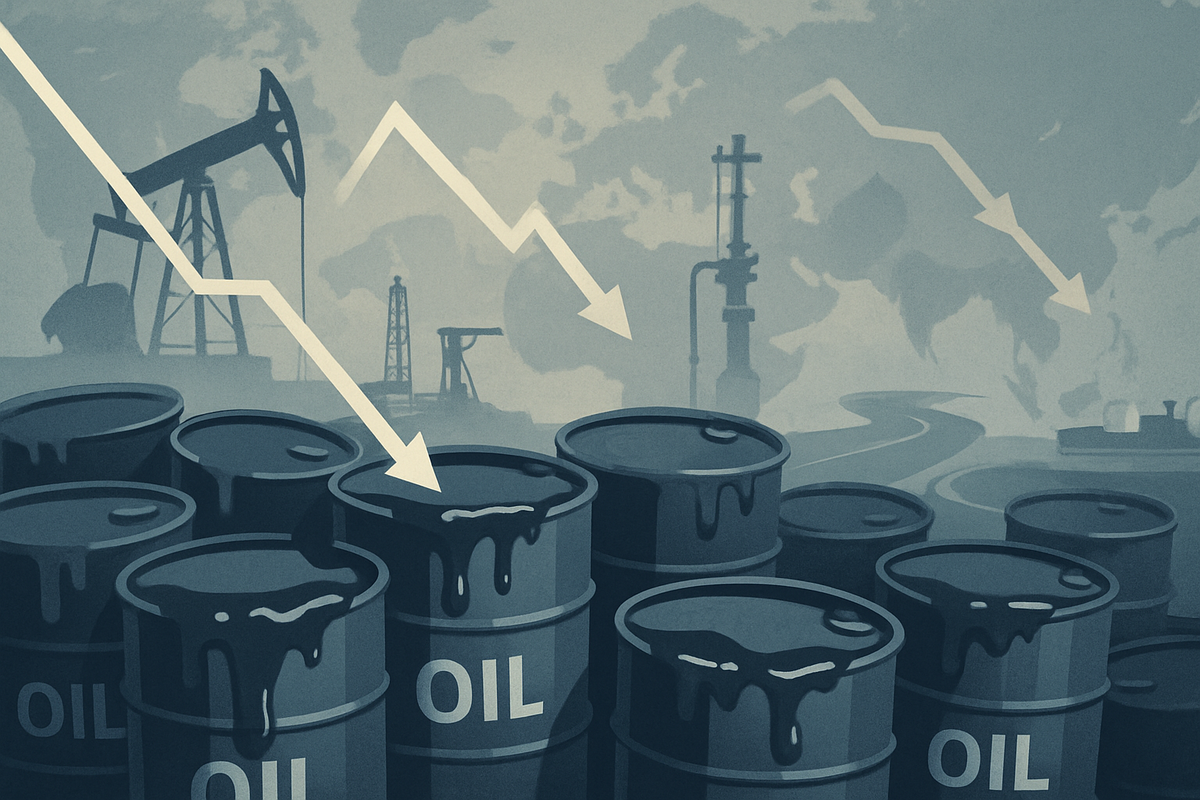
Crude oil prices are experiencing a notable retreat as of October 2, 2025, with benchmark Brent crude settling around $65-$66 per barrel and U.S. West Texas Intermediate (WTI) crude between $61-$62 per barrel. This significant decline marks multi-month lows, primarily driven by a robust increase in global supply coupled with signs of moderating demand. The immediate implications are a more volatile energy market, potential relief for consumers at the pump, and a challenging environment for high-cost producers.
The current downturn signals a shift in the global energy landscape, moving from a period of supply tightness to one of potential oversupply. This rebalancing act, influenced by strategic production decisions and evolving economic conditions, is poised to redefine profitability for energy companies and impact inflationary pressures across various economies. The market is now keenly watching how major oil producers respond to this bearish sentiment and what long-term effects this will have on energy transition efforts.
Global Supply Glut Drives Oil Market Downturn
The retreat in crude oil prices is a direct consequence of several key developments contributing to an increasing global supply. The Organization of the Petroleum Exporting Countries and its allies (OPEC+), for instance, have been steadily unwinding their previous production cuts. Following a 137,000 barrels per day (bpd) hike in October 2025, the cartel is reportedly considering further increases, potentially adding up to 500,000 bpd in November, as part of a strategy to regain market share. This strategic pivot by OPEC+ is a significant factor in the current oversupply narrative.
Simultaneously, the United States continues to be a formidable force in global oil production, achieving record output levels that significantly augment the worldwide supply. Weekly data consistently reveals unexpected surges in U.S. crude stockpiles, alongside higher-than-anticipated increases in gasoline and distillate inventories, signaling a domestic market awash with petroleum products. This robust U.S. output, combined with growth from other non-OPEC+ producers, creates a formidable wave of supply.
Adding to the supply surge is the crucial agreement reached for Iraq to resume crude oil exports from its Kurdistan region via a pipeline to Turkey. This restart is projected to inject an additional 230,000 to 500,000 bpd into global markets, further intensifying the supply-side pressure. Market analysts are now forecasting substantial global oil inventory accumulation, with builds expected to average over 2 million bpd from Q3 2025 through Q1 2026, a scenario that could lead to full commercial storage and the more costly reliance on floating storage.
Compounding the supply-side dynamics is a noticeable moderation in global demand. Weak economic indicators from major economies like China, India, and Brazil, coupled with contracting manufacturing activity across key Asian economies, have led to downward revisions in demand forecasts for 2025. India, the world's third-largest crude oil importer, reported a decline in crude imports in August, while U.S. petrol consumption has fallen to a six-month low. The ongoing structural shift towards electric vehicles and cleaner energy, alongside a recent U.S. federal government shutdown, further exacerbates concerns over slowing demand growth, cementing the pervasive bearish sentiment in the market.
Winners and Losers in a Retreating Oil Market
The current retreat in crude oil prices creates a distinct bifurcation of fortunes within the financial markets, with certain sectors and companies poised to benefit while others face significant headwinds.
Potential Winners:
- Airlines: Companies like Delta Air Lines (NYSE: DAL), United Airlines Holdings (NASDAQ: UAL), and Southwest Airlines Co. (NYSE: LUV) stand to gain substantially from lower fuel costs, which represent one of their largest operating expenses. Reduced jet fuel prices can directly improve profit margins, potentially leading to increased profitability and competitive pricing for consumers.
- Shipping and Logistics Companies: Global shipping giants such as A.P. Møller – Mærsk A/S (CPH: MAERSK B) and logistics providers like FedEx Corporation (NYSE: FDX) and United Parcel Service, Inc. (NYSE: UPS) will also see their operational costs decrease. Lower bunker fuel prices can enhance their profitability, especially in a highly competitive industry where fuel surcharges are a significant component of pricing.
- Consumers and Consumer Goods: Lower energy prices typically translate to reduced costs for transportation and manufacturing, offering relief to consumers through lower prices at the pump and potentially cheaper goods. This could boost consumer spending in other sectors.
- Oil-Importing Nations: Countries heavily reliant on oil imports, such as India, Japan, and most European nations, will benefit from a reduced import bill, potentially improving their trade balances and easing inflationary pressures.
Potential Losers:
- Exploration and Production (E&P) Companies: Independent E&P companies, particularly those with higher production costs, will be severely impacted. U.S. shale producers, including smaller players and even larger ones like Pioneer Natural Resources Company (NYSE: PXD) or EOG Resources Inc. (NYSE: EOG), might see squeezed profit margins, leading to reduced capital expenditure, slower drilling activity, and potential write-downs of assets. Their stock prices are likely to suffer.
- Integrated Oil Majors (Mixed Impact): Large integrated companies like Exxon Mobil Corporation (NYSE: XOM) and Chevron Corporation (NYSE: CVX) have a more mixed outlook. While their upstream (exploration and production) segments will feel the pinch of lower prices, their downstream (refining and marketing) operations might benefit from cheaper crude feedstock, potentially offsetting some of the losses. However, a prolonged downturn will still negatively impact their overall profitability and investment plans in new projects.
- Oilfield Services Companies: Companies providing services to the E&P sector, such as Schlumberger Limited (NYSE: SLB) and Halliburton Company (NYSE: HAL), will likely experience reduced demand for their drilling, completion, and well maintenance services as producers scale back operations. This could lead to lower revenues and potentially job losses.
- Oil-Exporting Nations: Countries whose economies are heavily dependent on oil exports, such as Saudi Arabia, Russia, and Nigeria, will face significant budgetary pressures. Lower oil revenues could force these governments to cut spending, impacting their domestic economies and potentially leading to social unrest.
Broader Implications and Historical Parallels
The current crude oil price retreat due to surging global supplies is more than just a momentary blip; it represents a significant shift within the broader energy industry. This event fits into a trend where the market is continually balancing geopolitical risks, OPEC+ strategies, and the relentless growth of non-OPEC+ production, particularly from the United States. The sustained downward pressure on prices highlights the market's capacity to absorb supply, even in the face of ongoing geopolitical tensions like the war in Ukraine, which traditionally offer underlying support to prices.
The ripple effects extend beyond direct competitors. For instance, the improved profitability for airlines and logistics companies could stimulate their respective sectors, leading to increased investment or expansion. Conversely, the financial strain on oil producers might lead to a slowdown in energy infrastructure projects, affecting engineering and construction firms that serve the oil and gas sector. Regulatory bodies and policymakers will also be watching closely. While lower prices might ease inflationary pressures, they could also reduce the incentive for investment in renewable energy projects if traditional fuels become significantly cheaper, potentially slowing down the energy transition. Governments of oil-importing nations might see this as an opportunity to bolster strategic petroleum reserves, while oil-exporting nations could face pressure to diversify their economies.
Historically, periods of significant crude oil oversupply have led to similar market dynamics. The mid-1980s saw a dramatic price collapse due to OPEC's struggle to maintain market share against rising non-OPEC production. More recently, the 2014-2016 oil price crash, largely driven by booming U.S. shale production and OPEC's decision not to cut output, offers a potent comparison. In both instances, high-cost producers faced severe challenges, leading to industry consolidation, bankruptcies, and a re-evaluation of capital allocation. The current scenario, with record U.S. output and strategic increases from OPEC+, echoes these past events, suggesting that the market may be entering another protracted period of lower prices, forcing a similar reckoning for producers.
The Road Ahead: Navigating a Supply-Rich Market
Looking ahead, the energy market faces a complex interplay of short-term adjustments and long-term strategic realignments. In the short term, analysts project that Brent crude could average $59-$62 per barrel in Q4 2025, with potential drops to $49-$50 per barrel by early 2026. This sustained downward pressure will necessitate immediate strategic pivots from oil producers, focusing on cost efficiency, optimization of existing assets, and potentially deferring new, higher-cost projects. For consumers, the immediate outlook is positive, with lower prices at the pump expected to persist, offering a boost to disposable income.
In the long term, the increasing global supply, coupled with moderating demand, presents both challenges and opportunities. Oil companies might need to accelerate their diversification into cleaner energy sources to mitigate revenue volatility from their core business. The divergence in energy markets, with crude oil facing downward pressure while natural gas (especially LNG) shows robust growth, highlights a potential shift in investment focus. This could lead to increased capital allocation towards gas infrastructure and renewable projects, positioning companies for a future with a more diversified energy mix.
Potential scenarios range from a prolonged period of low oil prices, forcing significant industry consolidation and a faster energy transition, to a more volatile market where geopolitical events or unexpected supply disruptions could temporarily push prices higher. However, the underlying trend of robust supply growth from both OPEC+ and non-OPEC+ producers suggests that any price rallies might be short-lived. Market opportunities may emerge for companies that can innovate in cost reduction, develop new technologies for enhanced oil recovery, or successfully pivot into renewable energy sectors. The challenges will primarily lie with high-cost producers and nations heavily reliant on oil revenues, necessitating economic diversification and fiscal prudence.
A New Chapter for the Global Oil Market
The current retreat in crude oil prices, driven overwhelmingly by surging global supplies from both OPEC+ and non-OPEC+ producers, marks a significant turning point for the global energy market. The key takeaway is a shift from a supply-constrained environment to one of potential oversupply, creating a pervasive bearish sentiment that is likely to persist into early 2026. This dynamic offers immediate relief to consumers and oil-importing nations through lower fuel costs and reduced inflationary pressures, while simultaneously squeezing profit margins for high-cost producers and presenting fiscal challenges for oil-exporting economies.
Moving forward, the market will be characterized by heightened volatility as it navigates this new supply-demand equilibrium. Investors should closely monitor the production decisions of OPEC+, particularly their upcoming November meeting, as well as U.S. crude inventory levels and global economic indicators for signs of demand recovery. The resilience of the U.S. shale industry under lower price environments will also be a critical factor, as will the pace of energy transition initiatives and their impact on long-term demand.
Ultimately, this period of retreating oil prices is not merely a cyclical downturn but potentially a structural adjustment. It underscores the increasing complexity of balancing energy security, economic growth, and environmental sustainability. Companies that adapt quickly, prioritize efficiency, and strategically diversify their energy portfolios will be best positioned to thrive in this evolving landscape. For the broader market, it signals a recalibration of energy costs that will have ripple effects across industries and economies for months to come.
This content is intended for informational purposes only and is not financial advice







